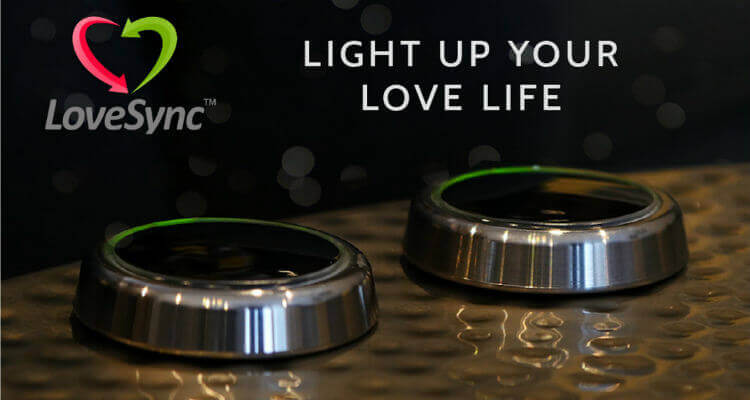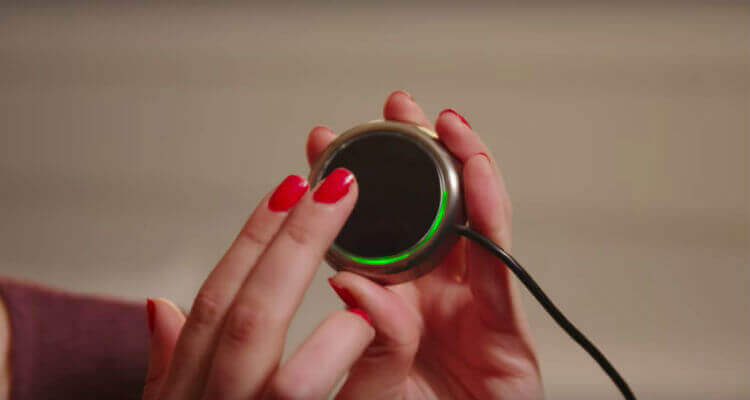Pushing Buttons: Is LoveSync Really The Worst Sex Tech—Ever?
Maybe it all comes down to what you consider to be a success.

“You’re in love, but you don’t always know when your partner is in the mood for romance… and sometimes you get shot down. So, you stop trying as often,” goes the very first pitch line on LoveSync’s Kickstarter page.
The solution, according to husband and wife developers Jenn and Ryan Cmich? Well, it involves pushing buttons.
Not in the negatively-emotional way but rather in a technological one: a button you can use to signal to your sexual partner that you’re interested in having intimate relations.
Or, as the pitch further goes: “With LoveSync there’s no rejection, no guilt, and no missed opportunities. Take the Luck out of Getting Lucky and make your move with confidence!”
Honestly, though, is this extra gear really needed, or is it a nearly comical symbol of the over-proliferation of unnecessary sex tech devices?
Or, conversely, can it honestly be a tool to help couples connect sexually with one another?
The thing is, when you get down to it, the answer may actually be a bit of both, but not necessarily in the way Jenn and Ryan may have considered.
How it all works
Hopefully without taking away the work that may have gone into developing it, the LoveSync is pretty far from being a sophisticated bit of tech.
In essence, it’s just a pair of buttons, though somewhat smart ones.
To get things moving, each unit is plugged into a USB power supply. After that, the two units wirelessly connect with one another, allowing one partner to tap one to indicate to the second unit that they are interested in having sex.
If the partner, using their own button, feels the same indicators will flash on both units. So, the idea goes, the fun can then begin.
To give some wriggle-room, each button also comes with a timer for this sign of interest—15 minutes up to 24 hours—after which the offer is deactivated.
Seriously, that’s it. Side-stepping the bigger issues for a moment, which we will most definitely get back to, LoveSync brings up a pretty big question: mainly, why?
From a sex tech perspective, the same thing could be done, with far greater options such as being able to have each person involved communicate their interest even when partners aren’t in the same space with one another, with an app.
This software version could even have the option of connecting erotic options, and not just a “sex now,” to the invitation—or even including more than one contact for the polyamorous folks out there.
In their defense, Jenn and Ryan have addressed this on their Kickstarter page, though their argument for choosing hardware over a software solution, such as that couples don’t always bring their phones into the bedroom, is pretty thin.
Interestingly, they’ve added a “coming soon” sign-up to their product page: indicating that an app version is most definitely on the way. This only begs another question: then why continue to make the physical buttons?
Here’s the thing though, despite all this LoveSync has managed to do what far too many crowdfunding campaigns have done: not just met their funding goals but go right into production.
That’s right, for better or for worse, you too can plop down $59.99 for a pair of buttons you can use to tell your partner that you want to have sex.
A measure of success?

So by one criteria, LoveSync has definitely done what it set out to do, and not only that but the product, and the couple behind it, have garnered some truly impressive publicity as well, having been touted by the likes of Cosmopolitan, The New York Post, and even Stephen Colbert.
Because of this, it’s not at all fair to call LoveSync a bad example of sex tech, at least not in regards to financial success.
Here’s the thing, though: while LoveSync pulled in dollars the basic idea behind it has certainly not been without its critics.
Some of them, such as this article from The Daily Dot, stating in a big, bold headline that “LoveSync represents the worst of sextech.”
And, you know what, they aren’t wrong.
A big step in the wrong direction
Keeping in mind that this is purely opinion and trying not to take away from the many people who supported, or happily continue to use it, but LoveSync is arguably the definition of making a serious problem even worse.
It goes like this: sex—and even more importantly sexual consent—is not a yes or no state of being. You can, after all, consent to one activity, renegotiate to do, or not do, other activities after that point or change your mind even before things get moving.
The core of this, though, is sex should always be about clear communication, to be able to mutually share desires, fears, concerns in a non-judgmental and safe space and then have what you say respected by the other person.
LoveSync encourages the opposite: it says pretty clearly that sex and the emotions around having quality intimate interactions with another human being can be reduced to mashing an “I’m horny” button.
Now, LoveSync’s developers have stated that their product shouldn’t replace talking but instead be a technological way to get the communication-between-couple’s ball rolling—though this is extremely hard to find on their Kickstarter or product page.
When all’s said and done, tying a button-press to sex doesn’t just trivialize and even dismiss the importance of communication and consent but in its own way actively encourages people to stay uncommunicative about such an extremely important subject.
And yet, just as saying that LoveSync for all its technological faults, is still a Kickstarter success story, it might have done some good. No doubt unintentional, but good nonetheless.
It’s all about communication

LoveSync has gotten people talking about talking about sex. True, most of these conversations do not put this product in a favorable light but that it has gotten a great number of people discussing it is far from a bad thing.
Quoted by a Verge article criticizing LoveSync, sexologist Kate McCombs put it very well, saying that communication has been, and always will be, the difference between a good or a bad time:
When you avoid those vital conversations, you might avoid some awkwardness, but you’re also settling for suboptimal sex.
So while some sort-of, kind-of good has come from LoveSync’s development and release what we really need are products that are profitable and, more than anything, do the world some actual good.
So here’s to sex tech that addresses how intelligence, conscientiousness, and most of all communication are the cornerstones to a joyous sex life—and never something to be avoided or even just sidestepped.
Image sources: LoveSync
Leave a reply
You must be logged in to post a comment.

















